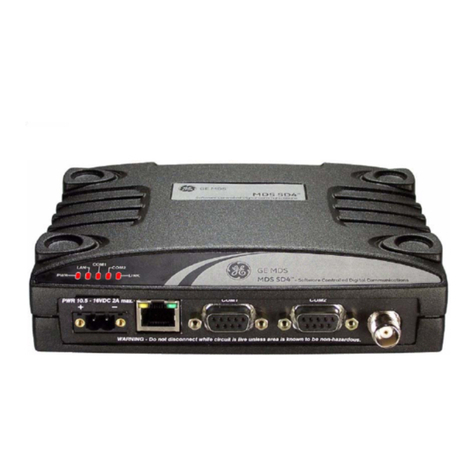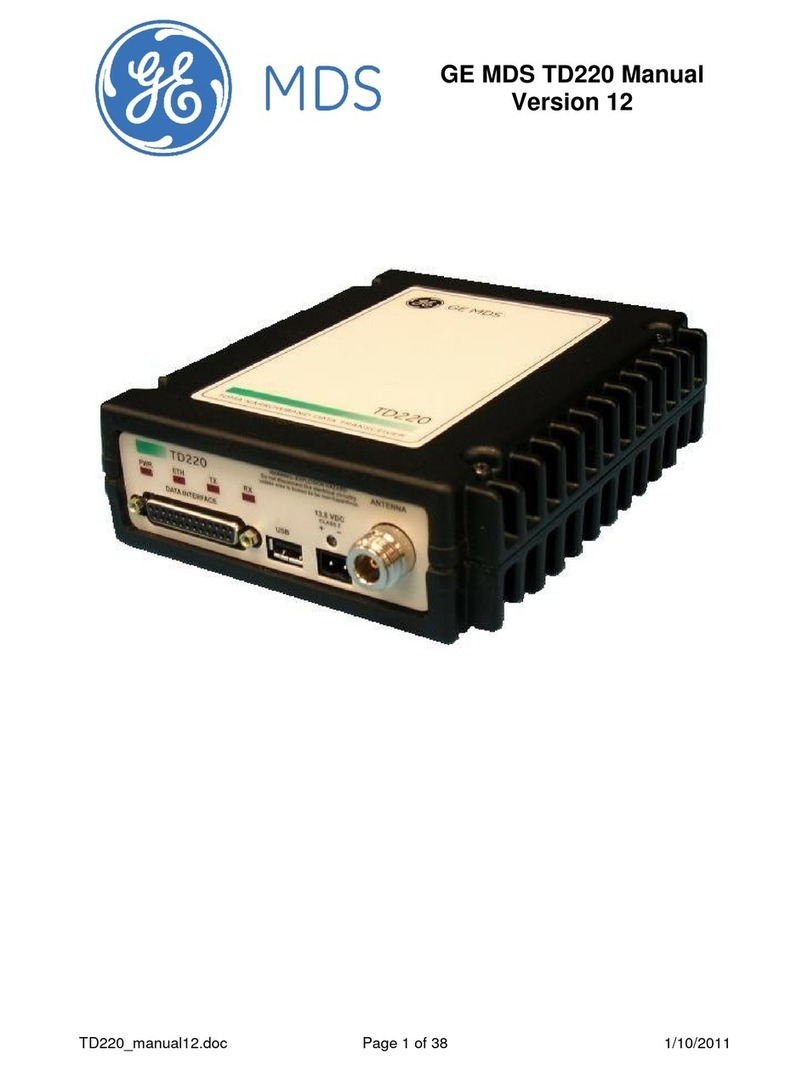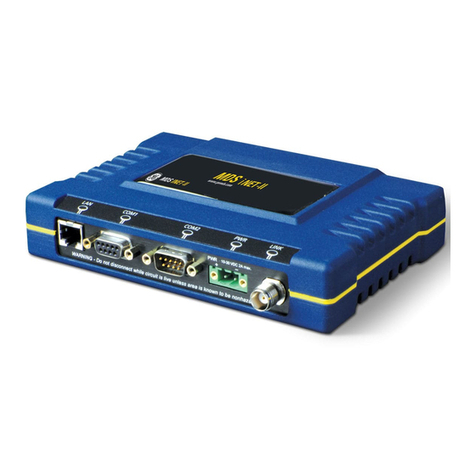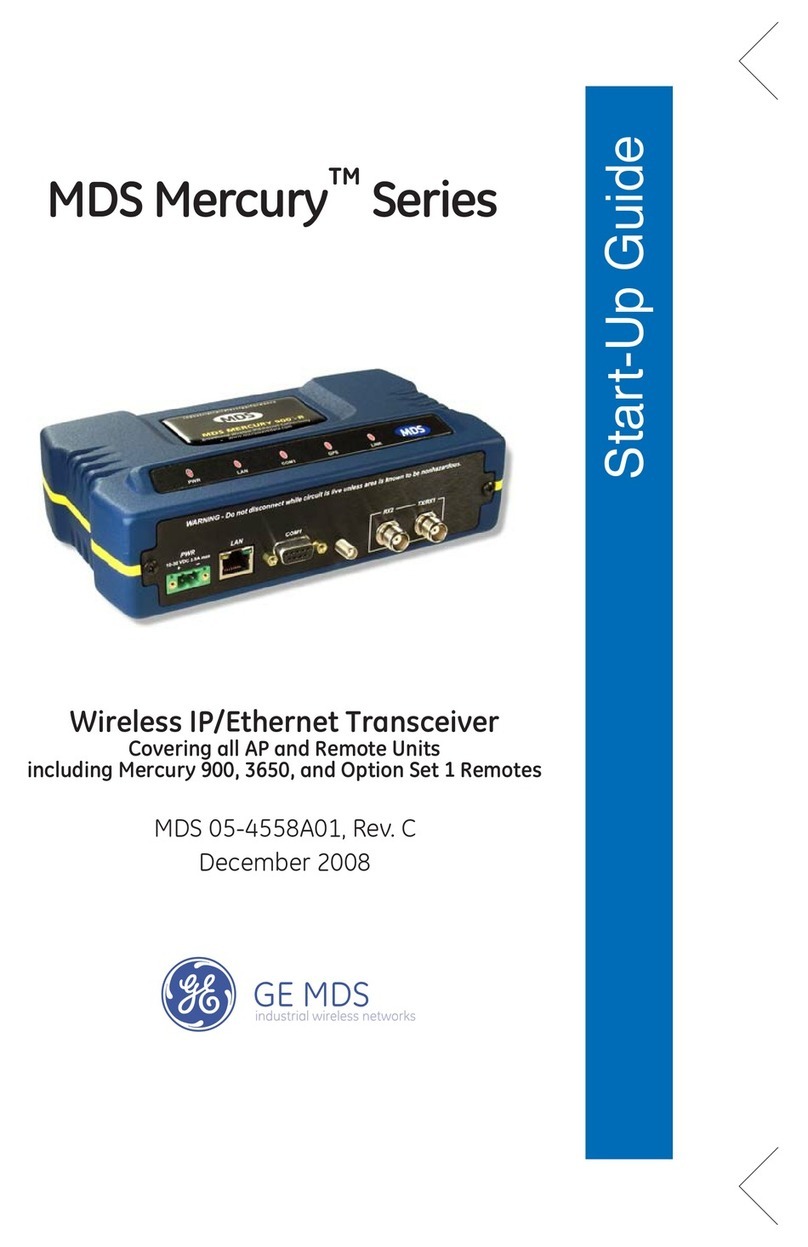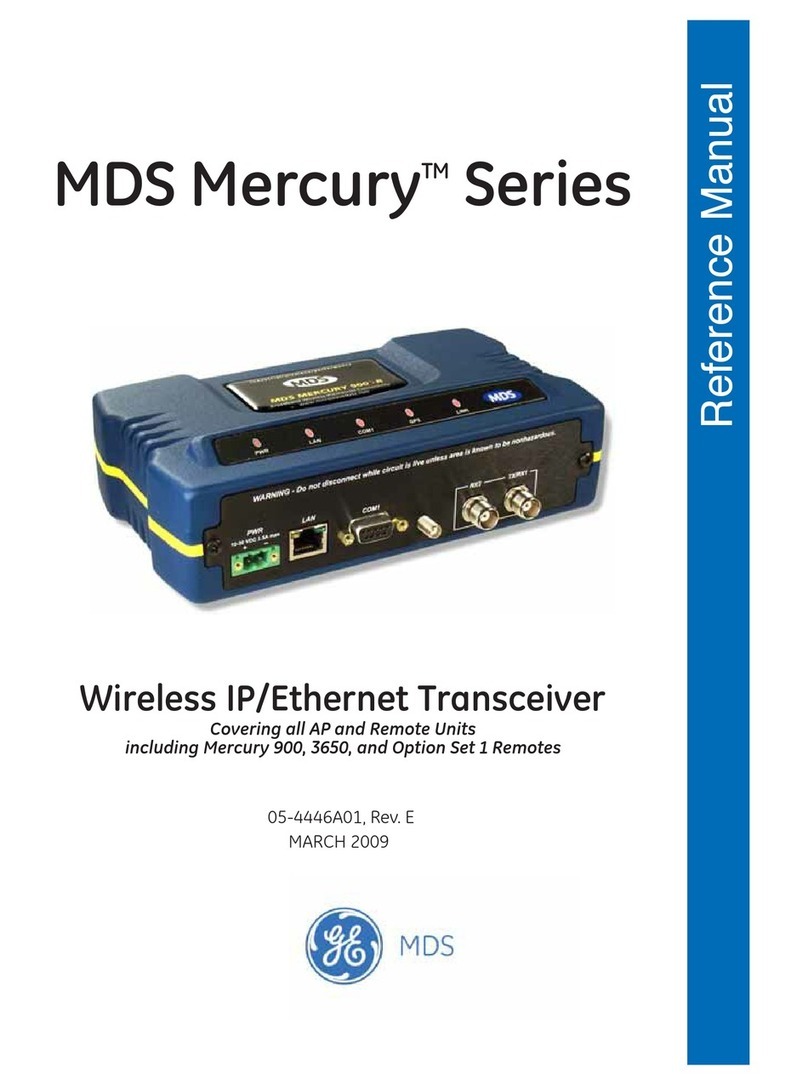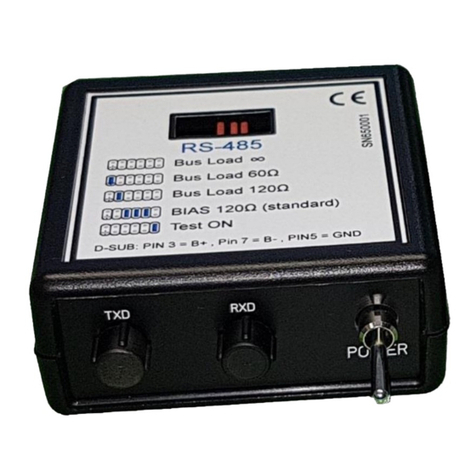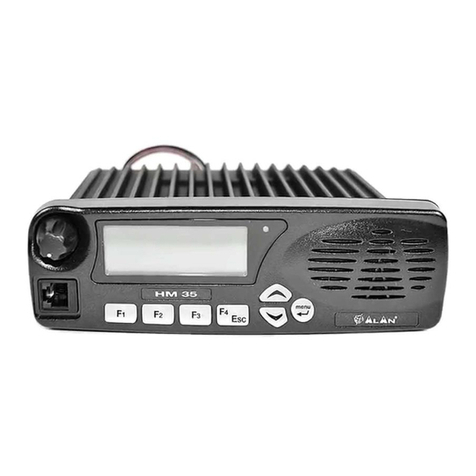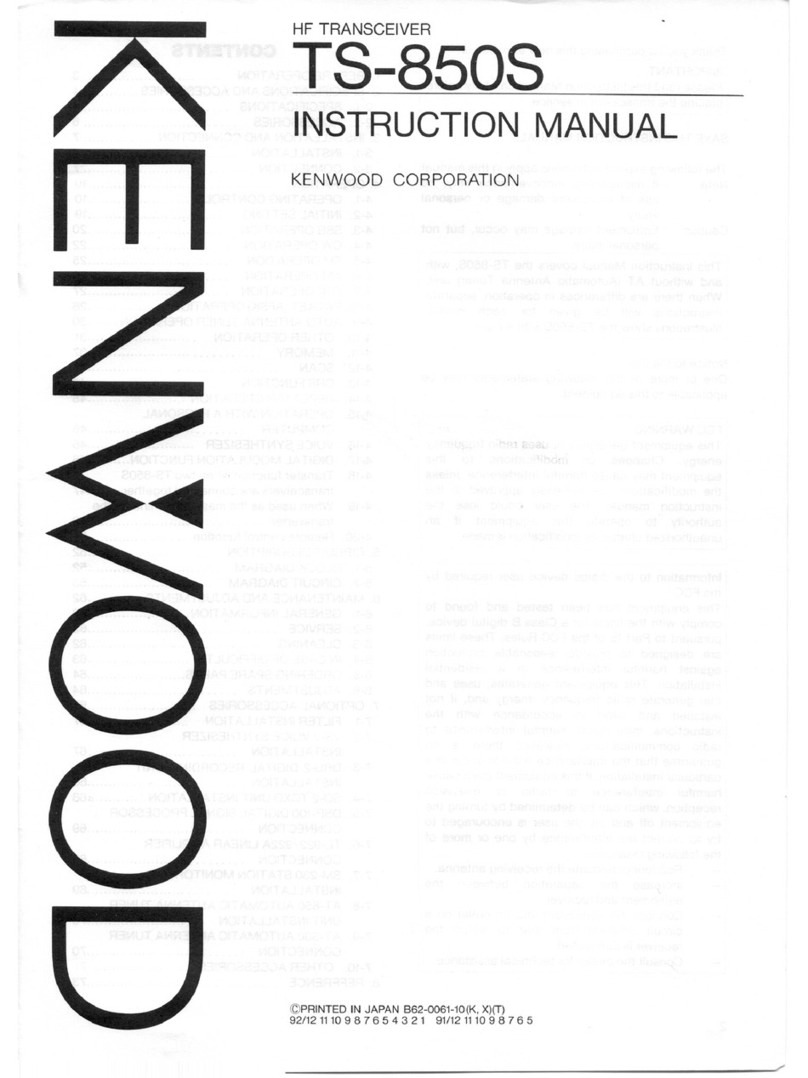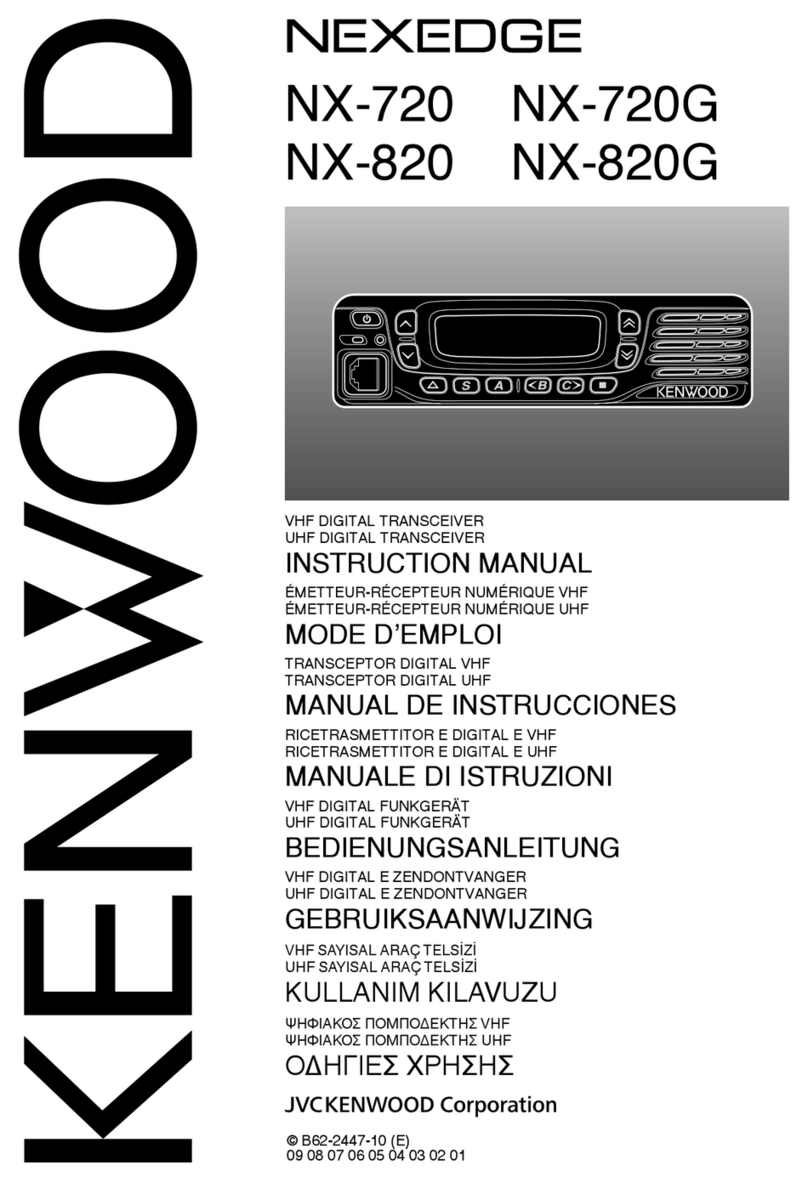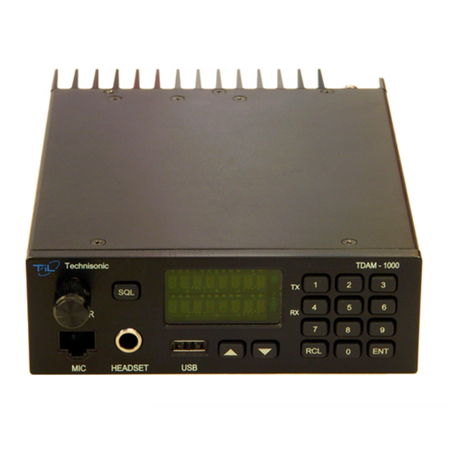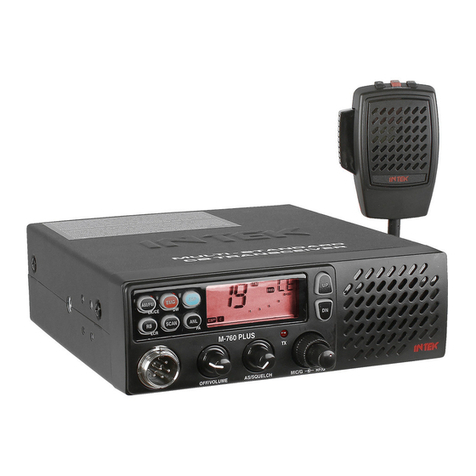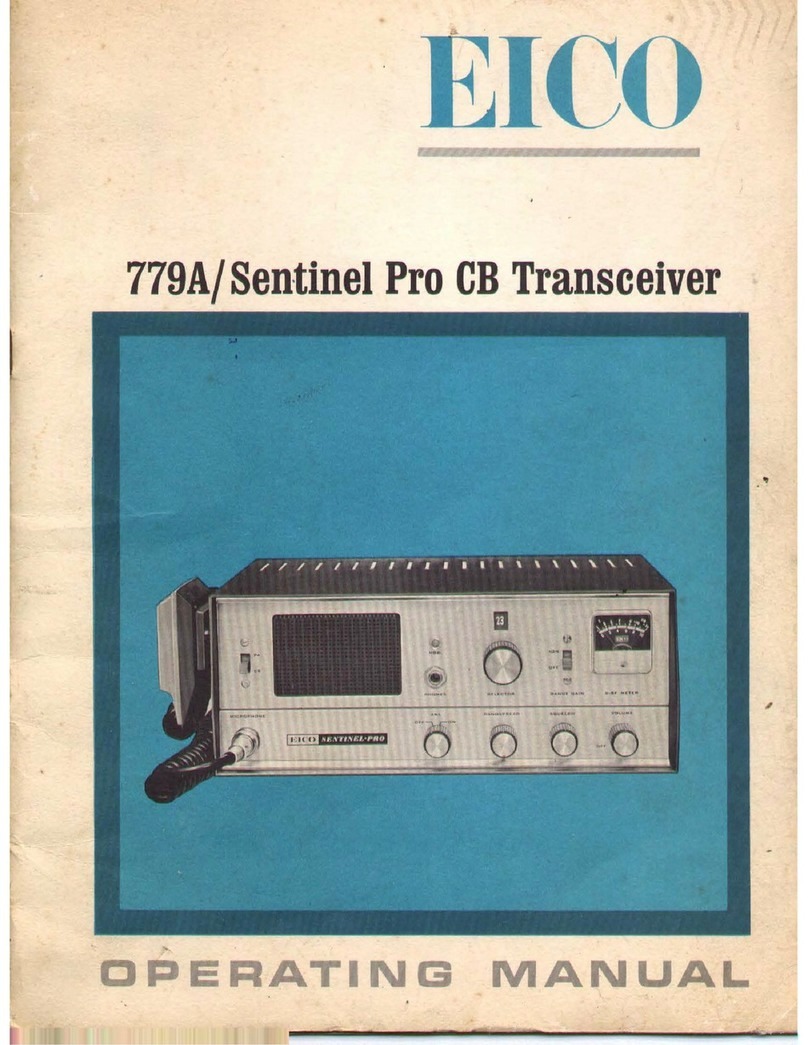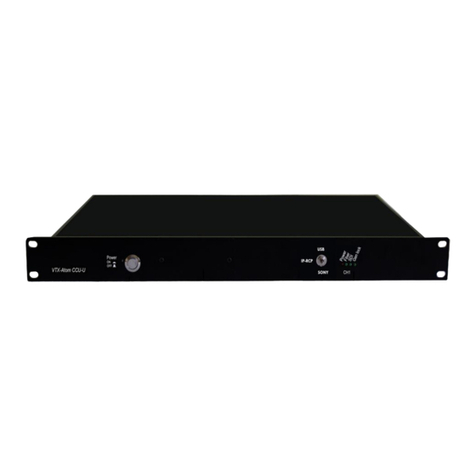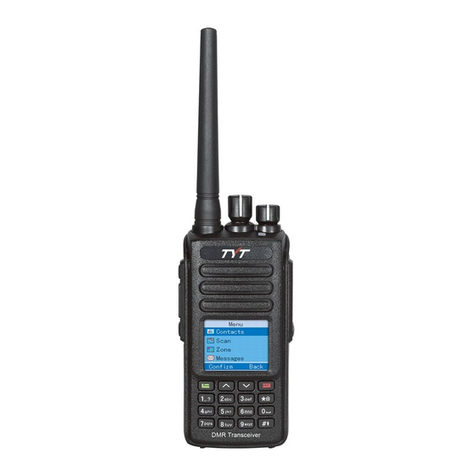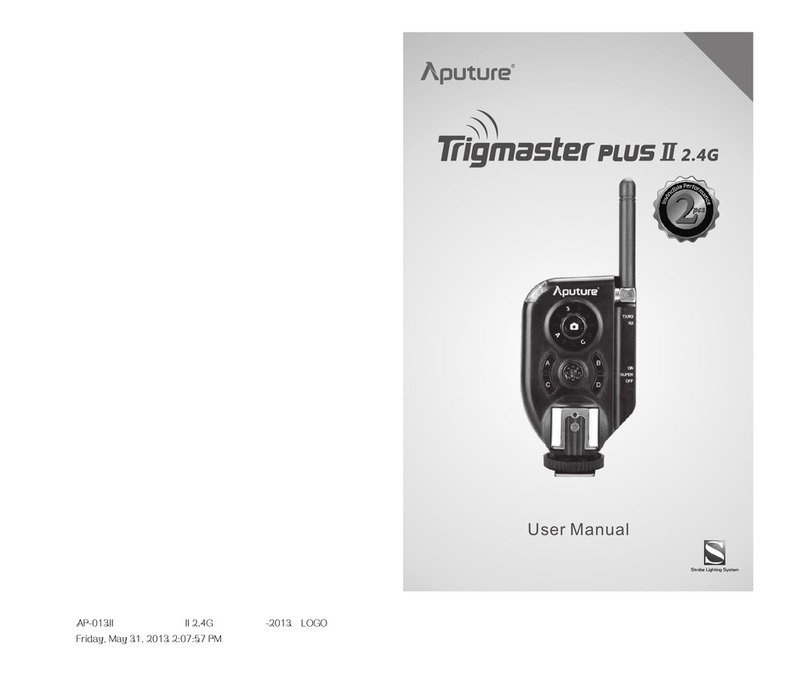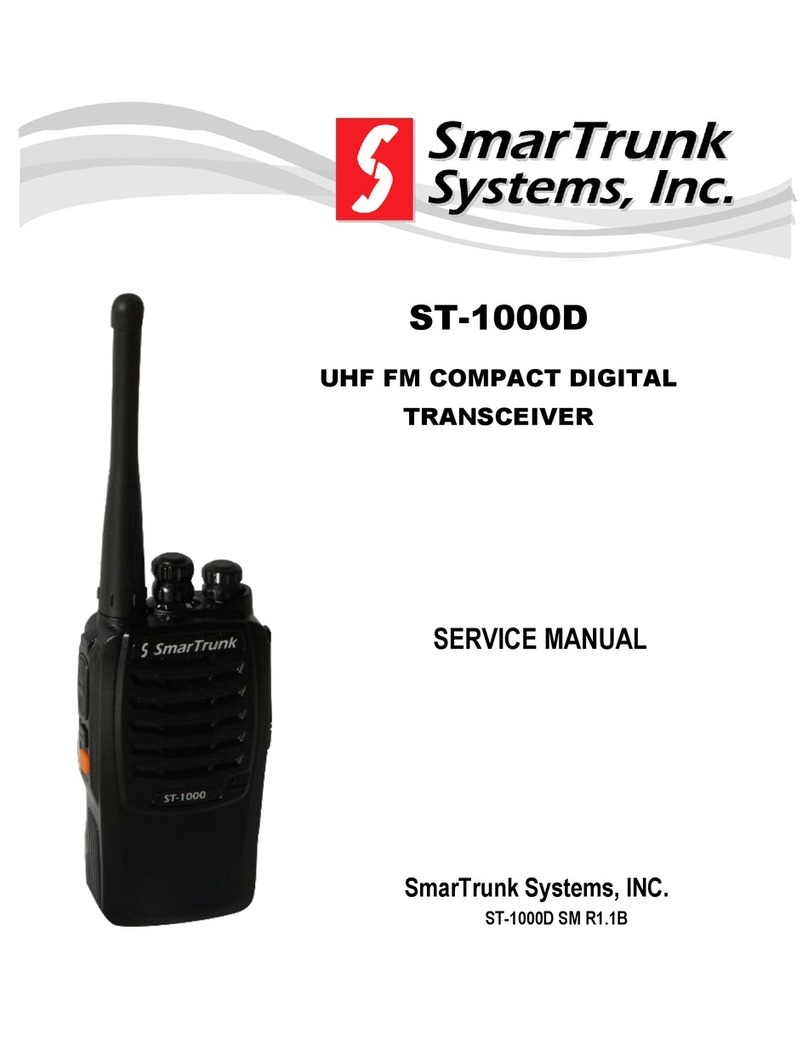GE MDS TransNET OEM EL806 User manual

Installation & Operation Guide
OEM Integration Guide
05-3946A01, Rev. C
JUNE 2007
MDS TransNET OEM
™
Spread Spectrum Data Transceiver
Transceiver Model EL806
Including Instructions for
03-4053A01 Evaluation Development Kit

The steps below contain the essential information needed to place the OEM trans-
ceiver in service. Because the transceiver is designed for use in other pieces of
equipment, these steps assume that prior testing and evaluation have been
conducted with the host device. If not, please refer to “EVALUATION DEVELOP-
MENT KIT (P/N 03-4053A01)” on Page 75 for interface wiring and configuration
details.
1. Mount the transceiver module using the four holes provided.
• If possible, select a mounting location that allows viewing the status LEDs and
provides ready access to the antenna connector.
• Use standoff hardware to secure the board to the host device.
• When mounting the board, use care to align the transceiver’s 16-pin header
connector with the mating pins in the host device.
2. Connect the antenna system to the transceiver
• Use only with antenna/feedline assemblies that have been expressly tested
and approved for such service by GE MDS.
• Use a matching connector to attach the antenna to the transceiver.
• For best performance, antennas should be mounted in the clear, with an
unobstructed path in the direction of desired transmission/reception.
3. Apply power and observe the LEDs for proper operation. The LED
command must be set to ON (LEDS ON).
After 16 seconds…
• The GP LED should be lit continuously
• The DCD LED should be lit continuously—if synchronization with another unit
has been achieved
• The Remote radio(s) should be transmitting data (TXD) and receiving data
(RXD) with its associated station
LED Indicator Descriptions
LED Name Description
RXD (CR3)
Receive Data
Serial receive data activity. Payload data from con-
nected device.
TXD (CR4)
Transmit Data
Serial transmit data activity. Payload data to con-
nected device.
DCD (CR5)
Data Carrier Detect
Continuous—Radio is receiving/sending synchro-
nization frames
On within 10 seconds of power-up under normal
conditions
GP (CR6)
General Purpose
• Continuous—Power is applied to the radio; no
problems detected
• Flashing (5 times-per-second)—Fault indication.
See “TROUBLESHOOTING” on Page 59
• Off—Radio is unpowered or in Sleep mode
QUICK START GUIDE
RXD
TXD
DCD
GP

05-3946A01, Rev. C TransNET OEM Integration Guide i
CONTENTS
1.0 ABOUT THIS MANUAL.................................................................. 1
2.0 PRODUCT DESCRIPTION .............................................................. 1
2.1 Transceiver Features ................................................................... 2
2.2 Factory Hardware Options ......................................................... 2
2.3 Data Interface and Power (J3) Options ...................................... 2
Antenna Connector (J200/J201)................................................. 3
2.4 Model Number ............................................................................ 3
2.5 Spread Spectrum Radios—How Are They Different? ............... 4
2.6 Typical Applications ................................................................... 4
Multiple Address Systems (MAS) ............................................. 4
Point-to-Point System................................................................. 5
Tail-End Link to an Existing Network ....................................... 5
Store-and-Forward Repeater ...................................................... 6
2.7 Transceiver Accessories ............................................................. 6
3.0 BENCHTOP SETUP & EVALUATION ........................................... 7
3.1 Initial Power-Up & Configuration .............................................. 8
Configuration Settings................................................................ 8
Configuring Multiple Remote Units........................................... 9
3.2 Tail-End Links ............................................................................ 9
3.3 Configuring a Network for Extensions ....................................... 10
3.4 LED Indicators ........................................................................... 10
4.0 TRANSCEIVER MOUNTING.......................................................... 11
4.1 Antenna & Feedline Selection .................................................... 13
Antennas..................................................................................... 13
Feedlines..................................................................................... 14
Antenna System Ground ............................................................ 15
5.0 PERFORMANCE OPTIMIZATION ................................................. 15
Antenna Aiming ......................................................................... 16
Antenna SWR Check.................................................................. 16

ii TransNET OEM Integration Guide 05-3946A01, Rev. C
Data Buffer Setting—MODBUS™ Protocol ............................. 16
Hoptime Setting.......................................................................... 16
TotalFlow™ Protocol at 9600 with Sleep Mode ........................ 17
Operation at 115200 bps............................................................. 17
Baud Rate Setting ....................................................................... 17
Radio Interference Checks.......................................................... 17
5.1 How Much Output Power Can be Used? .................................... 17
6.0 OPERATING PRINCIPLES & SPECIAL
CONFIGURATIONS ......................................................................... 19
6.1 Synchronizing Network Units .................................................... 19
Synchronization Messages ......................................................... 19
6.2 Establishing a Tail-End Link ...................................................... 20
6.3 SAF Operation with Extension Radios ....................................... 21
Simple Extended SAF Network ................................................. 21
Extended SAF Network.............................................................. 22
Retransmission and ARQ Operation .......................................... 22
SAF Configuration Example ...................................................... 23
6.4 Using AT Commands .................................................................. 23
Supported AT Commands........................................................... 24
Operating Notes when AT Commands are ON .......................... 25
6.5 Configuration Parameters for Store & Forward Services ........... 25
6.6 Using the Radio’s Sleep Mode (Remote Units Only) ................. 27
Sleep Mode Example.................................................................. 28
6.7 Low-Power Mode (LPM)—Master Enabled .............................. 28
Setup Commands........................................................................ 28
Reading RSSI & Other Parameters with LPM Enabled ............. 29
Power Consumption Influence by HOPTIME and SAF Settings29
6.8 Low-Power Mode versus Remote’s Sleep Mode ........................ 30
Introduction ................................................................................ 30
Operational Influences—Hoptime and SAF............................... 31
Master Station Configuration ..................................................... 32
Antenna System for Co-Located Master Stations ...................... 32
7.0 DEALING WITH INTERFERENCE ................................................ 33
Terminal Interface....................................................................... 34
PC-Based Configuration Tool .................................................... 35
8.2 User Commands .......................................................................... 35

05-3946A01, Rev. C TransNET OEM Integration Guide iii
Entering Commands ................................................................... 35
8.3 Detailed Command Descriptions ................................................ 41
ADDR [1–65000] ....................................................................... 41
AMASK [0000 0000–FFFF FFFF] ............................................ 42
AT [ON, OFF] ............................................................................ 42
ASENSE [HI/LO]....................................................................... 42
BAUD [xxxxx abc] .................................................................... 42
BAND [A, B, C]......................................................................... 43
BUFF [ON, OFF] ....................................................................... 43
CODE [NONE, 1…255] ............................................................ 43
CSADDR [1–65000, NONE] ..................................................... 44
CTS [0–255] ............................................................................... 44
CTSHOLD [0–60000]................................................................ 44
DEVICE [DCE, CTS KEY] ...................................................... 45
DLINK [xxxxx/ON/OFF]........................................................... 45
DKEY......................................................................................... 45
DTYPE [NODE/ROOT] ............................................................ 46
FEC [ON, OFF].......................................................................... 46
HOPTIME [7, 28]....................................................................... 46
INIT ............................................................................................ 46
HREV ......................................................................................... 48
KEY............................................................................................ 48
LED [ON, OFF] ......................................................................... 48
LPM [1, 0] .................................................................................. 48
LPMHOLD [0–1000] ................................................................. 49
MODE [M, R, X] ....................................................................... 49
MRSSI [NONE, –40...–90] ........................................................ 49
OT [ON, OFF]............................................................................ 50
OWM [xxxxx] ............................................................................ 50
OWN [xxxxx]............................................................................. 50
PORT [RS232, RS485]............................................................... 50
PWR [20–30].............................................................................. 50
REPEAT [0–10].......................................................................... 51
RETRY [0–10] ........................................................................... 51
RSSI............................................................................................ 51
RTU [ON, OFF, 0-80] ................................................................ 52
RX [xxxx]................................................................................... 52
RXD [0–255].............................................................................. 52
RXTOT [NONE, 0–1440] .......................................................... 52

iv TransNET OEM Integration Guide 05-3946A01, Rev. C
SAF [ON, OFF] .......................................................................... 53
SETUP ........................................................................................ 53
SER............................................................................................. 53
SHOW CON ............................................................................... 53
SHOW PWR............................................................................... 54
SHOW SYNC............................................................................. 54
SKIP [NONE, 1...8].................................................................... 54
SLEEP [ON, OFF]...................................................................... 55
SREV.......................................................................................... 55
STAT ........................................................................................... 55
TEMP.......................................................................................... 56
TX [xxxx] ................................................................................... 56
UNIT [10000–65000] ................................................................. 56
XADDR [0–31] .......................................................................... 56
XMAP [00000000-FFFFFFFF].................................................. 56
XPRI [0–31] ............................................................................... 57
XRSSI [NONE, –40...–120] ....................................................... 57
ZONE CLEAR ........................................................................... 57
ZONE DATA .............................................................................. 57
Checking for Alarms—STAT command .................................... 58
Major Alarms versus Minor Alarms........................................... 59
Alarm Codes’ Definitions........................................................... 59
9.2 LED Indicators ............................................................................ 60
9.3 Troubleshooting Chart ................................................................ 61
Saving a Web-Site Firmware File Onto Your PC ....................... 63
Using the I/O Points with InSite™ NMS Software.................... 73
Application Example—Digital Input/Output at Remote ............ 73
Evaluation PC Board .................................................................. 74
Connecting the Transceiver & Evaluation Board ....................... 75
Antenna Connection—Transceiver Module, J200/201 .............. 76
DC Power Connector, J3 ............................................................ 77
Diagnostic Connection, J4.......................................................... 77
DATA Connector, J5................................................................... 78
Transceiver Power Interface, J1 ................................................. 80
Assembly Drawing ..................................................................... 81
Parts List ..................................................................................... 81
Evaluation PCB Interface to Transceiver PCB, J2 ..................... 83
PCB Schematic ........................................................................... 83

05-3946A01, Rev. C TransNET OEM Integration Guide v
To Our Customers
We appreciate your patronage. You are our business. We promise to serve and antici-
pate your needs. We strive to give you solutions that are cost effective, innovative,
reliable and of the highest quality possible. We promise to build a relationship that is
forthright and ethical, one that builds confidence and trust. We are committed to the
continuous improvement of all of our systems and processes, to improve product
quality and increase customer satisfaction.
Copyright Notice
This Installation and Operation Guide and all software described herein are Copyright
2007 by GE MDS, LLC. All rights reserved. The company reserves its right to correct
any errors and omissions in this manual.
RF Exposure Notice
ISO 9001 Registration
GE MDS adheres to the internationally-accepted ISO 9001 quality system standard.
FCC Part 15 and Industry Canada RSS Notice
This device complies with Part 15 of the FCC Rules and Industry Canada
license-exempt RSS standard(s). Operation is subject to the following two conditions:
(1) this device may not cause interference, and (2) this device must accept any
inter-ference that may cause undesired operation of the device.
a) Under Industry Canada regulations, this radio transmitter may only operate using
an antenna of a type and maximum (or lesser) gain approved for the transmitter by
Industry Canada. To reduce potential radio interference to other users, the antenna
type and its gain should be so chosen that the equivalent isotropically radiated power
(e.i.r.p.) is not more than that necessary for successful communication.
Professional installation required. The radio equipment described in this
guide emits radio frequency energy. Although the power level is low, the
concentrated energy from a directional antenna may pose a health
hazard. Do not allow people to come closer than 23 cm (9 inches) to the
antenna when the transmitter is operating in indoor or outdoor
environ-ments.
In mobile applications (vehicle mounted) the above separation distance
must be maintained at all times. More information on RF exposure is
available on the Internet at www.fcc.gov/oet/info/documents/bulle-
tins.
L'énergie concentrée en provenance d'une antenne directionnelle peut
présenter un danger pour la santé. Ne pas permettre aux gens de
s'approcher à moins de 23 cm à l'avant de l'antenne lorsque l'émetteur
est en opération. On doit augmenter la distance proportionnellement si
on utilise des antennes ayant un gain plus élevé . Ce guide est destiné à
être utilisé par un installateur professionnel. Plus d'informations sur
l'exposition aux rayons RF peut être consulté en ligne à l'adresse
suiv-ante: www.fcc.gov/oet/info/documents/bulletins
RF EXPOSURE

vi TransNET OEM Integration Guide 05-3946A01, Rev. C
b) The radio transmitter described herein (IC ID: 3738A-MDSEL806) is approved by
Industry Canada to operate with the antenna types listed below with the maximum
per-missible gain and required antenna impedance for each antenna type indicated.
Antenna types not included in this list, having a gain greater than the maximum gain
indicated for that type, are strictly prohibited for use with this device.
Warning: Changes or modifications not expressly approved by the manufacturer could
void the user’s authority to operate the equipment.
Cet appareil est conforme à la Partie 15 des règlements de la FCC et Industrie Canada
exempts de licence standard RSS (s). Son utilisation est soumise à deux conditions:
(1) ce dispositif ne peut causer des interférences, (2) cet appareil doit accepter toute
interférence pouvant causer un mauvais fonctionnement du dispositif.
a) En vertu des règlements d'Industrie Canada, cet émetteur radio ne peut fonctionner
avec une antenne d'un type et un maximum (ou moins) approuvés pour gagner de
l'émetteur par Industrie Canada. Pour réduire le risque d'interférence aux autres
util-isateurs, le type d'antenne et son gain doivent être choisies de façon que la puis-
sance isotrope rayonnée équivalente (PIRE) ne dépasse pas ce qui est nécessaire pour
une communication réussie.
b) L'émetteur radio décrit ci-après (IC ID: 3738A-MDSEL806) a été approuvé par
Industrie Canada pour fonctionner avec les types d'antennes énumérées ci-dessous
avec le gain maximal admissible et nécessaire antenne d'impédance pour chaque type
d'antenne indiqué. Types d'antennes ne figurent pas dans cette liste, ayant un gain
supérieur au gain maximum indiqué pour ce type, sont strictement interdites pour une
utilisation avec cet appareil.
Antenna Gain/Power Data (FCC)
Antenna System Gain
(Antenna Gain in dBia
minus Feedline Loss in dBb)
a. Most antenna manufacturers rate antenna gain
in dBd. To convert to dBi, add 2.15 dB.
b. Feedline loss varies by cable type and length.
Consult manufacturer data.
Maximum Power
Setting
(in dBm) EIRP
(in dBm)
6 (or less) 30 36
82836
10 26 36
12 24 36
14 22 36
16 20 36

05-3946A01, Rev. C TransNET OEM Integration Guide vii
Antenna Gain/Power Data (Industry Canada )
FCC Limited Modular Approval
This device is offered as an FCC Part 15 Unlicensed Limited Modular Transmitter
(LMA). The transmitter module is approved for use only with specific antenna, cable
and output power configurations that have been tested and approved for use when
installed in devices approved by third-party OEMs, or produced by the Grantee (GE
MDS). Modifications to the radio, the antenna system, or power output, that have not
been explicitly specified by the manufacturer are not permitted, and may render the
radio non-compliant with applicable regulatory authorities. Refer to Table 10 on
Page 28 for more detailed information.
When this device is placed inside an enclosure, a durable label must be affixed to the
outside of that enclosure indicating the unit’s FCC ID Number.
The antenna(s) to be used with this module must be installed with consideration to the
guidelines for RF exposure risk to all nearby personnel, and must not be co-located or
operating in conjunction with any other antenna or transmitter.
Changes or modifications not expressly approved by the party responsible for compli-
ance could void the user’s authority to operate the equipment.
UL Notice
The MDS TransNET OEM 900 (Model EL806) and TransNET OEM
2400 (Model EL806-24) is available for use in Class I, Division 2, Groups
A, B, C & D Hazardous Locations. Such locations are defined in Article
500 of the National Fire Protection Association (NFPA) publication
NFPA 70, otherwise known as the National Electrical Code.
Both transceivers models have been recognized for use in these hazardous locations
by the Canadian Standards Association (CSA). The transceiver is as a Recognized
Component for use in these hazardous locations, in accordance with CSA STD C22.2
No. 213-M1987.
UL Conditions of Approval:
Antenna System Gain
(Antenna Gain in dBia
minus Feedline Loss in dBb)
a. Most antenna manufacturers rate antenna gain
in dBd. To convert to dBi, add 2.15 dB.
b. Feedline loss varies by cable type and length.
Consult manufacturer data.
Maximum Power
Setting
(in dBm) EIRP
(in dBm)
0 dBi Dipole 28.5 36
2 dBi Dipole 28.5 36
7.1 dB Omni 28.5 36
8.5 dBi Yagi 27 36

viii TransNET OEM Integration Guide 05-3946A01, Rev. C
The transceiver is not acceptable as a stand-alone unit for use in the hazardous loca-
tions described above. It must either be mounted within another piece of equipment
which is certified for hazardous locations, or installed within guidelines, or conditions
of approval, as set forth by the approving agencies. These conditions of approval are
as follows:
1. The transceiver must be mounted within a separate enclosure which is suitable for
the intended application.
2. The coaxial antenna cable, power input cable and interface cables must be routed
through conduit in accordance with Division 2 wiring methods as specified in the
National Electrical Code, Article 501.4(B).
3. The transceiver must be used within its Recognized “Ratings”.
4. Installation, operation and maintenance of the transceiver should be in accordance
with the transceiver's installation manual, and the National Electrical Code.
5. Tampering or replacement with non-factory components may adversely affect the
safe use of the transceiver in hazardous locations, and may void the approval.
6. A power connector with screw-type retaining screws as supplied by GE MDS
must be used.
When installed in a Class I, Div. 2, Groups A, B, C or D hazardous location, observe
the following:
WARNING — EXPLOSION HAZARD
Do not disconnect equipment unless power has been
switched off or the area is know to be non-hazardous.
Substitution of components may impair
suitability for Class 1, Division 2.
Refer to Articles 500 through 502 of the National Electrical Code (NFPA 70) for fur-
ther information on hazardous locations and approved Division 2 wiring methods.
ESD Notice
To prevent malfunction or damage to this radio, which may be caused by
Electrostatic Discharge (ESD), the radio should be properly grounded by
connection to the ground stud on the rear panel. In addition, the installer or
operator should follow proper ESD precautions, such as touching a
grounded bare metal object to dissipate body charge, prior to adjusting
front panel controls or connecting or disconnecting cables on the front or
rear panels.
Environmental Information
The equipment that you purchased has required the extraction and use of
natural resources for its production. Improper disposal may contaminate
the environment and present a health risk due to hazardous substances con-
tained within. To avoid dissemination of these substances into our environ-
ment, and to diminish the demand on natural resources, we encourage you
to use the appropriate recycling systems for disposal. These systems will
reuse or recycle most of the materials found in this equipment in a sound
way. Please contact GE MDS or your supplier for more information on the
proper disposal of this equipment.

05-3946A01, Rev. C TransNET OEM Integration Guide ix
Manual Revision and Accuracy
While every reasonable effort has been made to ensure the accuracy of this manual,
product improvements may result in minor differences between the manual and the
product shipped to you. If you have additional questions or need an exact specification
for a product, please contact our Customer Service Team using the information at the
back of this guide. In addition, manual updates can often be found on the GE MDS
Web site at www.GEmds.com.

x TransNET OEM Integration Guide 05-3946A01, Rev. C

05-3946A01, Rev. C TransNET OEM Integration Guide 1
1.0 ABOUT THIS MANUAL
This manual is intended to guide technical personnel in the integration of
MDS TransNET OEM™transceiversintoexisting electronicequipment.The
OEM transceiver is designed for use inside Remote Terminal Units (RTUs),
Programmable Logic Controllers (PLCs) and other equipment associated
with remote data collection, telemetry and control.
The manual provides instructions for interface connections, hardware
mounting, and programming commands. Following integration of the trans-
ceiver, it is recommended that a copy of this manual be retained for future
reference by technical personnel.
2.0 PRODUCT DESCRIPTION
The OEM transceiver, (Figure 1), is a compact, spread spectrum wireless
module designed for operation in the 900 and 2400 MHz license-free
frequency bands. It is contained on one double-sided circuit board with all
necessary components and RF shielding included. It need only be protected
from direct exposure to the weather and is designed for rugged service in
extreme temperature environments.
The transceiver has full over-the-air compatibility with standard (non-OEM)
TransNET transceivers manufactured by GE MDS. All transceiver program-
ming is performed via a personal computer or terminal connected to the
module. There are no manual adjustments required to configure the trans-
ceiver for operation.
Invisibleplaceholder
Figure 1. TransNET OEM™ Transceiver
The transceiver employs Digital Signal Processing (DSP) technology for
highly-reliable data communications, even in the presence of weak or inter-
fering signals. DSP techniques also make it possible to obtain information
about the radio’s operation and troubleshoot problems, often eliminating the
need for site visits.
Using appropriate software at the master station, diagnostic data can be
retrieved for any radio in the system, even while payload data is being trans-
mitted. (See “Performing Network-Wide Remote Diagnostics” on Page 61.)

2 TransNET OEM Integration Guide 05-3946A01, Rev. C
2.1 Transceiver Features
TheOEM transceiver isdesigned for easy installationandflexibility in awide
range of wireless applications. Listed below are several key features of the
transceiver which are described in more detail later in this guide.
• 902–928 MHz operation using the TransNET OEM 900
• 2400–2482 MHz operation using the TransNET OEM 2400
• User-selectable option to skip sub-bands with constant interference
• 65,000 available network addresses
• Network-wide configuration from the Master station eliminates most
trips to Remote sites
• Datatransparencyensures compatibility with virtually all asynchronous
SCADA system RTUs
• Peak-hold RSSI averaged over eight hop cycles
• Operation at up to 115,200 bps continuous data flow
• Store-and-Forward repeater operation
• Data latency typically less than 10 ms
• Same hardware for Master or Remote configuration
• Supports RS/EIA-232 and RS/EIA-485 user interface
• Low current consumption; typically less than 3 mA in “sleep” mode
NOTE: Some radio features may not be available on all models, or limited by the options pur-
chased, or the applicable regulatory constraints for the region in which the radio will op-
erate.
2.2 Factory Hardware Options
There are a number options for the transceiver assembly that must be speci-
fied at the time the order. These include: antenna connector type, data inter-
face signalling and primary power.
2.3 Data Interface and Power (J3) Options
Table 1 below lists the interface options that can be specified when the trans-
ceiver module is ordered. If you are uncertain as to the configuration of the
unit you are using, please copy the model number code from the transceiver
module and contact the GE MDS Customer Service Department for assis-
tance.

05-3946A01, Rev. C TransNET OEM Integration Guide 3
Antenna Connector (J200/J201)
The PCB has solder pads for several RF connectors with different footprints
but only one RF connector will be installed. Below is a table of connector
options available from the factory when the order is placed. We do not recom-
mend retrofitting the PCB with an alternate connector as damage to the board
could result and will void the factory warranty.
2.4 Model Number
The radio model number is printed on the label on the end of the radio’s enclo-
sure. It provides key information about how the radio was configured when it
left the factory. This number is subject to many variations depending on what
options are installed and where (country) the product is used. Contact the fac-
tory if you have questions on the meaning of the code.
Table 1. Data Interface & Power Options
(Factory Configurable Only)
PAYLOAD DATA DIAGNOSTICS DATA INPUT POWER
RS-232/485 RS-232 +6–30 Vdc
TTL RS-232 +6–30 Vdc
TTL TTL +6–30 Vdc
Table 2. Antenna Connector Options
Connector Description
MMCX, JACK, RIGHT ANGLE
MCX, JACK, RIGHT ANGLE
MCX, STRAIGHT JACK RECEPTACLE
MCX, STRAIGHT PLUG RECEPTACLE
SMB, CON, COAX SMB RIGHT ANGLE
SMB, STRAIGHT JACK RECEPTACLE
SMA, JACK, RIGHT ANGLE RECEPTACLE
SMA, PLUG RECEPTACLE, RIGHT ANGLE
SMA, STRAIGHT JACK RECEPTACLE
SMA, STRAIGHT PLUG RECEPTACLE

4 TransNET OEM Integration Guide 05-3946A01, Rev. C
2.5 Spread Spectrum Radios—How Are They Different?
The main difference between a traditional (licensed) radio and the
MDS TransNET transceiver is that this unit “hops” from channel to channel
many times per second using a specific hop pattern applied to all radios in the
network. A distinct hopping pattern is provided for each of the 65,000 avail-
able network addresses, thus minimizing the chance of interference with
other spread spectrum systems. In the USA, Canada, and certain other coun-
tries, no license is required to install and operate this type of radio system,
provided that RF power and antenna gain restrictions are observed.
2.6 Typical Applications
Multiple Address Systems (MAS)
This is the most common application of the transceiver. It consists of a central
control station (master) and two or more associated remote units, as shown in
Figure 2. This type of network provides communications between a central
host computer and remote terminal units (RTUs) or other data collection
devices. The operation of the radio system is transparent to the computer
equipment. This application provides a practical alternative to traditional
(licensed) MAS radio systems.
Invisibleplaceholder
Figure 2. Typical MAS Network
MASTER SITE
DATA
TRANSCEIVER
RTU/PLCWITH
TRANSCEIVER
INSTALLED
RTU/PLCWITH
TRANSCEIVER
INSTALLED
RTU/PLCWITH
TRANSCEIVER
INSTALLED
RTU/PLCWITH
TRANSCEIVER
INSTALLED

05-3946A01, Rev. C TransNET OEM Integration Guide 5
Point-to-Point System
A point-to-point configuration (Figure 3) is a simple arrangement consisting
of just two radios—a master and a remote. This provides a half-duplex
communications link for the transfer of data between two locations.
Invisibleplaceholder
Figure 3. Typical Point-to-Point Link
Tail-End Link to an Existing Network
A tail-end link is often used to extend the range of a traditional (licensed)
MAS system without adding another licensed radio. This might be required
if an outlying site is blocked from the MAS master station by a natural or
man-made obstruction. In this arrangement, a spread spectrum transceiver
links the outlying remote site into the rest of the system by sending data from
that site to an associated transceiver installed at one of the licensed remote
sites—usually the one closest to the outlying facility. (See Figure 4).
As the data from the outlying site is received at the associated transceiver, it
is transferred to the co-located licensed radio (via a data crossover cable) and
is transmitted to the MAS master station over the licensed channel. Addi-
tional details for tail-end links are given in Section 6.2 (Page 19).
Invisibleplaceholder
Figure 4. Typical Tail-End Link Arrangement
Master Site Remote Site
Host System
DATA
TRANSCEIVER DATA
TRANSCEIVER
REPEATER STATION
Remote Radio
ENTER
ESCAPE
ACTIVE
ACTIVE
STBY ALARM RXALR TX ALR
STBY ALARM RXALR TXALR LINE
LINE
Null-Modem Cable
Remote
Radio
Remote
Radio
Master Station
SPREAD SPECTRUM LINK
TO OUTLYING SITE
OUTLYING
REMOTE SITE
MAS SYSTEM (LICENSED OR UNLICENSED) LICENSE-FREE SPREAD SPECTRUM SYSTEM
RTU RTU
RTU
DATA
TRANSCEIVER
DATA
TRANSCEIVER

6 TransNET OEM Integration Guide 05-3946A01, Rev. C
Store-and-Forward Repeater
Similar to a Tail-End Link, Store-and-Forward (SAF) offers a way to physi-
cally extend the range of a network, but in a simplified and economical
manner. SAF operates by storing up the data received from one site, and then
retransmitting it a short time later. Figure 5 shows a typical SAF repeater
arrangement.
SAF operates by dividing a network into a vertical hierarchy of two or more
sub-networks. Extension radios (designated as MODE X) serve as single-radio
repeaters that link adjacent sub-networks, and move data from one
sub-network to the next. Additional information on SAF mode is provided in
“SAF Operation with Extension Radios” on Page 20.
Invisibleplaceholder
Figure 5. Store-and-Forward Repeater Network
2.7 Transceiver Accessories
One or more of the accessories listed in Table 3 may be used with the OEM
transceiver. Contact your factory representative for availability and ordering
details. Table 3. OEM Transceiver Accessories
Accessory Description Part No.
AC Power
Adapter Small power supply module designed for con-
tinuous service. UL approved.
Input: 120/220 Vac
Output: 12 Vdc @ 500 mA (20 Watts)
01-3682A02
2-Pin
DC Power Plug Mates with power connector on the transceiver.
Screw terminals are provided for wires. 73-1194A39
Fuse (Internal) Fuse, 2A SMF Slo-Blo 29-1784A03
Omnidirectional
Antennas Rugged antennas suited for use at Master
stations. Various;
Consult factory
900 MHz
Yagi Antennas Rugged directional antennas suited for use at
Remote stations. Various;
Consult factory
Programmed as
MODE X
STORE & FORWARD REPEATER STATION
SPREAD SPECTRUM LINK
TO OUTLYING SITE
OUTLYING
REMOTE SITE
Programmed as
MODE M
Programmed as
MODE R Programmed as
MODE R
Programmed as
MODE R
RTU RTU RTU
RTU
DATA
TRANSCEIVER
DATA
TRANSCEIVER
DATA
TRANSCEIVER
DATA
TRANSCEIVER DATA
TRANSCEIVER

05-3946A01, Rev. C TransNET OEM Integration Guide 7
3.0 BENCHTOP SETUP & EVALUATION
As an integrator, your first task is to verify that the OEM module will function
as intended with the host equipment. This section describes how to test the
unit for operation with host devices such as RTUs, PLCs and similar gear. It
covers the steps for making interface connections, powering up the trans-
ceiver, and setting configuration parameters using a connected PC.
Evaluation of the module is best performed in a controlled environment, such
as a shop or lab facility where you can readily test various hardware and
programming configurations and observe the effects of these changes before
final installation.
Once you are satisfied that the transceiver module operates properly on the
bench, you can plan the installation of the module inside the host device and
be assured of proper operation in the field.
NOTE: Before using the Evaluation PCB, please review the detailed information on the Eval-
uation PCB and its functions, see “EVALUATION DEVELOPMENT KIT (P/N
03-4053A01)” on Page 73.
2400 MHz
Antennas Rugged directional antennas suited for use at
Remote stations. Various;
Consult factory
900 MHz
Bandpass Filter Antenna system filter to aid in eliminating in-
terference from paging system transmissions. 20-2822A02
TNC-to-N
Adapter Cable
(3 ft./1 meter)
Coaxial cable used to connect the radio’s TNC
antenna connector to a Type-N style commonly
used on large-diameter coaxial cables.
97-1677A159
TNC-to-N
Adapter Cable
(6 ft./1.8 meter)
Coaxial cable used to connect the radio’s TNC
antenna connector to a Type-N style commonly
used on large-diameter coaxial cables.
97-1677A160
TNC-to-N RF
Adaptor Plug Adapts radio’s antenna connector to Type-N
style commonly used on large-diameter coaxial
cables.
97-1677A161
RS/EIA-232
Cable Shielded data cable fitted with DB-9 male and
DB-9 female, 6 ft./1.8 meter. 97-1971A03
RJ-11 to DB-9
Adapter Cable For connecting a PC terminal to the transceiver
via the radio’s DIAG(nostics) connector. Used
for programming and diagnostics.
03-3246A01
Evaluation
Development Kit Kit containing two OEM Transceiver modules,
whip antennas, two Evaluation Boards, support
software on CD, cables, power supplies and
other accessories needed to operate the trans-
ceiver in a benchtop setting.
32-4051A01
Table 3. OEM Transceiver Accessories (Continued)

8 TransNET OEM Integration Guide 05-3946A01, Rev. C
3.1 Initial Power-Up & Configuration
When all of the cable connections described in “Cable Connections for
Benchtop Testing” on Page 75 have been made, the transceiver is ready for
initial power-up. Operation begins as soon as power is applied, and there are
no manual adjustments or settings required.
To place the transceiver into operation:
1. Ensure that all cable connections are properly wired and secure. Verify
that no metallic objects are touching the underside of the evaluation
board which might cause a short-circuit.
2. Apply DC power. The GP indicator (CR6) on the transceiver board
should light continuously.
3. Using a connected PC terminal, configure the unit with the proper mode
(master or remote), network address and data parameters. See
Configuration Settings below for programming details.
4. Observe the transceiver’s LED indicators for proper operation. Table 4
on Page 11 shows the functions and normal indications of the LEDs.
5. Verify that the transceiver is transmitting and receiving data (TXD, RXD)
in response to the master station and/or connected terminal device.
Configuration Settings
This section explains how to set the essential operating parameters of the
transceiver. For more information on connecting a PC terminal, refer to“User
Commands” on Page 34.
6. The three essential settings for the Transceiver are as follows:
Mode—Master, Remote, or Extension
Network Address—a unique number from 1 to 65000
Data Interface Parameters—bps, data bits, parity, stop bits
a. Set the Mode using the MODE M (Master), MODE R (Remote), or
MODE X (Extension) command. (Note that there can be only one
Master radio in a system.)
If any MODE X radios are used in the network, SAF must be turned
on at the Master station. The MODE X radio must be programmed
with an Extended Address (XADDR). Units that need to hear the
MODE X radio must be programmed with an appropriate XPRI
and/or XMAP value. (See “SAF Operation with Extension Radios”
on Page 20 for more information.)
b. Set a unique Network Address (1–65000) using ADDR command.
Each radio in the system must have the same network address. Tip:
Use the last four digits of the Master’s serial number to help avoid
conflicts with other users.
Table of contents
Other GE MDS Transceiver manuals
Popular Transceiver manuals by other brands

Elcon
Elcon EL-31 Construction, operational and functional description
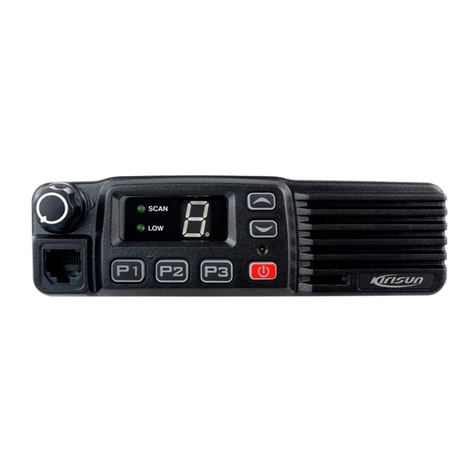
Kirisun
Kirisun PT8000 instruction manual
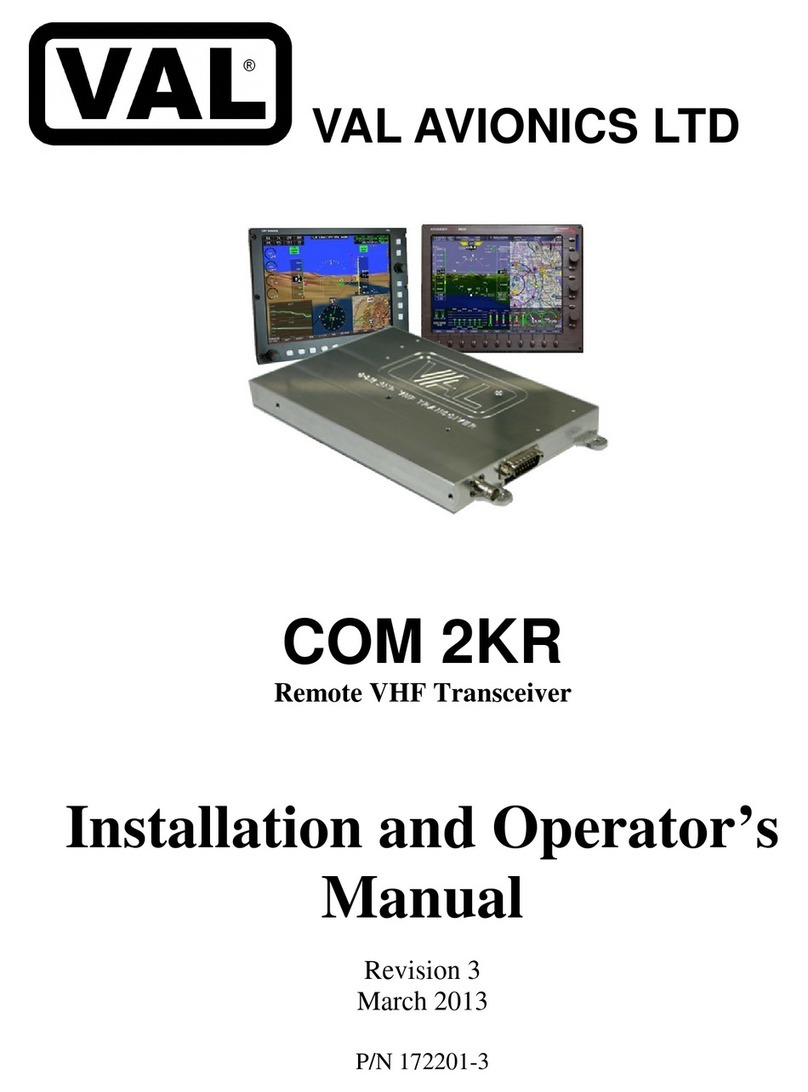
VAL Avionics
VAL Avionics COM 2KR Installation and operator's manual

Luthor
Luthor TL 22 user manual

Standard Horizon
Standard Horizon HX870 owner's manual

Tandy
Tandy Realistic PRO-43 Service manual
